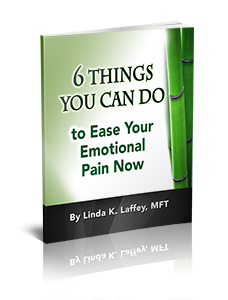By Linda K. Laffey, MFT
The term is bandied around in the news and on talk shows as people try to make sense of the world and all of its troubling situations.
- “Traumatic events” on college campuses.
- “Post-traumatic stress” affects veterans and their families.
- “Childhood trauma” continues to plague more adults than we know.
Most of us have probably been exposed to all of those terms. But what do they really mean?
What does trauma look like? How do you know if you’ve actually experienced it?
And if you believe that you are traumatized, are there ways to know if what you’re feeling is detrimental enough to seek treatment?
What exactly is trauma?
Trauma is the aftermath of a disturbing event or set of events. Emotional and psychological trauma occurs when something happens that is so disturbing it changes your world, or the perception of it, dramatically. Something stressful, tragic, threatening, or worse happens to destroy your peace of mind and sense of security, self-worth and self-esteem. The unexpected, cruelty, or repeated nature of the disruption can compromise your attachments and ruin your ability to have healthy relationships.
How does trauma affect me?
Whatever the circumstance, your trauma is likely to leave you internally shaken, feeling isolated or misunderstood, and dealing with a pervasive sense of powerlessness. The frightening roller coaster of emotions and memories caused by severe trauma are difficult to overcome.
There is a biological perspective to consider as well. The stress of trauma can also induce changes to the limbic system in your brain. That’s where your unresolved emotional memory exists. There, traumatic recollections and impressions can live and covertly make trouble for your body and mind. If you do not deal with the trauma, the trauma can be repeatedly triggered and grow in intensity.
Are there distinctions between types of trauma?
Yes. The Diagnostic and Statistical Manual for Mental Disorders (DSM) does distinguish two trauma categories: “Big T” traumas and “Little T” traumas.
“Big T” traumas, also known as discrete or severe trauma. These are catastrophic events that may have been the result of direct exposure, witnessed, or experienced by someone close to you. Examples include:
- Injury, or the threat of injury.
- Sexual abuse or assault.
- Natural disaster.
- Severe physical, emotional, or sexual abuse.
- A loved one’s death.
- Traffic accident.
- Major health problem.
- Abandonment or rejection by a significant person in your life.
- A deep relationship betrayal.
- Exposure to military combat or violent crime.
“Little T” traumas. This is a type of chronic trauma. It is more recurring trauma experience than major trauma exposure. Examples include:
-
Childhood neglect.
-
Addictions.
-
Bullying or harassment.
-
Chronic pain.
-
Ongoing criticism or rejection by a loved one.
So what does trauma feel like, look like, or sound like?
You may endure a tornado, cancer treatments or a divorce and feel equally traumatized. Trauma is a subjective experience, but there are some general symptoms to look for:
-
Mental symptoms.
-
Upset and denial.
-
Irritation and mood swings.
-
Sadness or hopelessness.
-
Anxiety, worry, and fear.
-
Confusion, lack of concentration.
-
Guilt and shame.
-
Isolation and withdrawal.
-
Emotional numbness.
-
Physical symptoms.
-
Sleeplessness, nightmares.
-
Jumpiness.
-
Muscle tension.
-
Exhaustion.
-
Edginess and agitation.
-
Accelerated pulse.
Reminders of trauma can exacerbate symptoms. Processing trauma will alleviate symptoms for good and start your healing.
The severity of traumatic experiences varies from person to person, but therapy can help you recover. You’ll need help to recover a sense of safety and to achieve forward movement.
If trauma is getting in your way, reach out to a professional who can help you determine the right treatment and coping tools to restore your peace of mind.

